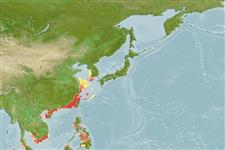>
Clupeiformes (Herrings) >
Dorosomatidae (Gizzard shads and sardinellas)
Etymology: Clupanodon: Latin, clupea = sardine, derived from Clupeus = shield; doubtless a reference to the scales covering the body of the fish (Ref. 45335).
More on author: Linnaeus.
Environment: milieu / climate zone / intervalo de profundidade / distribution range
Ecologia
marinhas; Água doce; estuarina pelagic-neritic; anádromo (Ref. 51243); intervalo de profundidade 0 - 50 m (Ref. 188). Tropical; 41°N - 6°N, 98°E - 128°E (Ref. 188)
Northwest Pacific: China, apparently south to Viet Nam (Philippine records of Fowler appear doubtful). Eastern Indian Ocean: Specimens were recorded from Phuket Island, Thailand (Andaman Sea).
Tamanho / Peso / Idade
Maturidade: Lm ? range ? - ? cm
Max length : 26.0 cm SL macho/indeterminado; (Ref. 188)
Espinhos dorsais (total) : 0; Espinhos anais: 0; Raios anais moles: 22 - 28. Body moderately deep; belly with 16 to 19 (usually 18) + 9 to 12 (usually 10 or 11) total 27 to 31 (usually 29 or 30) scutes; pre-dorsal scutes present, 17 to 26 (usually 20 to 25). gill rakers of first arch at least 3/4 length of gill filaments. Vertebrae 43 to 46 (usually 44 or 45). A dark spot behind gill opening, followed by further spots on flank.
Body shape (shape guide): fusiform / normal; Cross section: compressed.
Found in coastal waters and in rivers, presumably tolerating brackish water, if not fully fresh condition. More data needed.
Life cycle and mating behavior
Maturidade | Reprodução | Desova | Ovos | Fecundidade | Larvas
Whitehead, P.J.P., 1985. FAO Species Catalogue. Vol. 7. Clupeoid fishes of the world (suborder Clupeoidei). An annotated and illustrated catalogue of the herrings, sardines, pilchards, sprats, shads, anchovies and wolf-herrings. FAO Fish. Synop. 125(7/1):1-303. Rome: FAO. (Ref. 188)
Categoria na Lista Vermelha da IUCN (Ref. 130435: Version 2024-2)
Ameaça para o homem
Reports of ciguatera poisoning (Ref. 4690)
Utilização humana
Pescarias: espécies comerciais
Ferramentas
Relatórios especiais
Descarregue XML
Fontes da internet
Estimates based on models
Preferred temperature (Ref.
123201): 24 - 29, mean 27.4 °C (based on 184 cells).
Phylogenetic diversity index (Ref.
82804): PD
50 = 1.0000 [Uniqueness, from 0.5 = low to 2.0 = high].
Bayesian length-weight: a=0.00741 (0.00457 - 0.01201), b=3.14 (3.00 - 3.28), in cm total length, based on LWR estimates for this species & (Sub)family-body (Ref.
93245).
Nível Trófico (Ref.
69278): 3.1 ±0.3 se; based on size and trophs of closest relatives
Generation time: 3.1 ( na - na) years. Estimated as median ln(3)/K based on 2
growth studies.
Resiliência (Ref.
120179): Elevada, tempo mínimo de duplicação da população menor que 15 meses (Assuming tm=1).
Prior r = 1.19, 95% CL = 0.79 - 1.79, Based on 1 data-limited stock assessment.
Fishing Vulnerability (Ref.
59153): Low to moderate vulnerability (27 of 100).
🛈
Climate Vulnerability (Ref.
125649): Very high vulnerability (78 of 100).
🛈
Nutrients (Ref.
124155): Calcium = 190 [104, 334] mg/100g; Iron = 1.8 [1.1, 2.9] mg/100g; Protein = 19 [18, 20] %; Omega3 = 0.415 [0.238, 0.736] g/100g; Selenium = 38 [19, 72] μg/100g; VitaminA = 34.9 [15.0, 81.3] μg/100g; Zinc = 1.58 [1.12, 2.27] mg/100g (wet weight);
